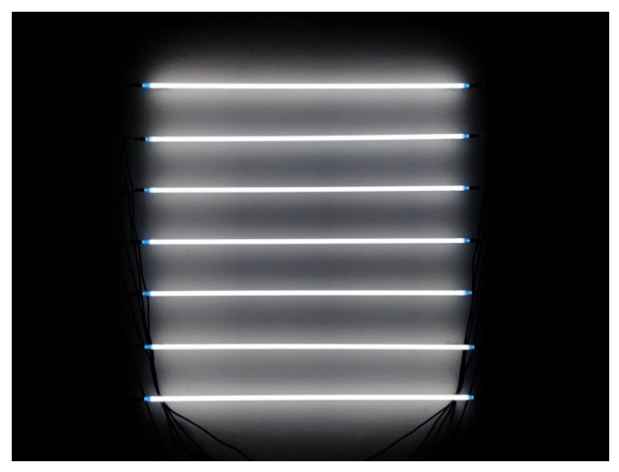Romily Alice Walden “My Body is the House that I Live In”
Soho20 Chelsea Gallery

This event has ended.
SOHO20 presents My Body is the House that I Live In, an installation by Romily Alice Walden that speaks to the artist’s experience of living with a chronic illness and disability.
The installation consists of 7 white neon tubes, placed horizontally, one below the other, on the gallery wall. Each tube corresponds to a facet of ‘wellness’: physical, emotional, mental/intellectual, occupational, sexual, social and spiritual. Every hour, the artist will assign each wellness category a number from 0-10, 0 being no wellness in that category and 10 being full wellness; that number will determine each tube’s brightness for the next hour. At 0 the tube will be off; for each number up to 10 the tube will glow fractionally brighter, with a score of 10 corresponding to full brightness. This is done using a technique that Walden developed in 2017 that uses Arduino/ESP8266 modules to adjust the light output of neon tubes remotely, using C++ coding. In this way the work becomes an ever-evolving portrait of living with sickness, one that views disability as a political issue, moving illness out of isolation and into the public realm.
This work developed out of a realisation that Western society views pain and sickness as experiences that should be confined to private spaces; as Susan Wendell (2006 p.247)* writes:
The public world is the world of strength, the positive (valued) body, performance and production, the able-bodied and youth. Weakness, illness, rest and recovery, pain, death and the negative (de-valued) body are private, generally hidden, and often neglected. Coming into the public world with illness, pain or a de-valued body, we encounter resistance to splitting the two worlds; the split vividly reveals itself.
With My Body Is The House That I live In the artist installs a durational performance of their own disabled experience, inviting an audience to confront the monotonous reality of living with a chronic health condition, and to challenge their own internalised notions of wellness/sickness, disabled/able-bodied binaries. The cold white colouring and trailing cables echo the sterile medical environment, the aversion of eyes in public streets, and the perceived (and felt) imposition of sickness upon the able-bodied public.
Walden invites a different (trans or cis) disabled woman or gender-nonconforming person to control the work for each week that it is exhibited. In this way, the gallery space is transformed into a living document of sickness, bringing chronic illness/disability out of private bedrooms and sick beds, and into the public space.
*Wendell, S. (2006). Toward a Feminist Theory of Disability. In: L. Davis, ed., The Disability Studies Reader, 2nd ed. London: Routledge, pp.243-256.
Image: My Body Is The House That I Live In, 2018.
Media
Schedule
from February 08, 2019 to March 08, 2019
Opening Reception on 2019-02-08 from 18:00 to 21:00